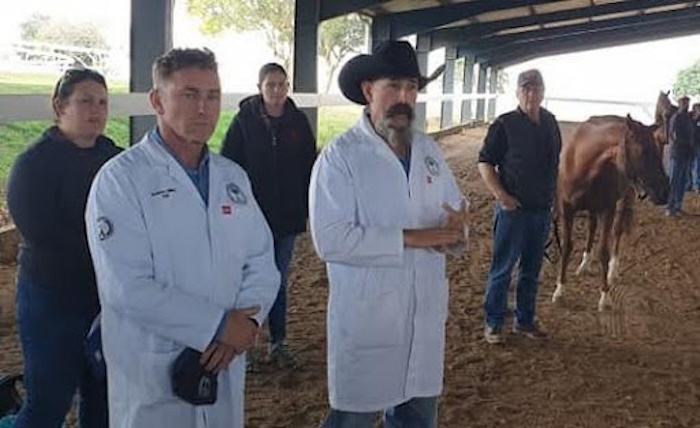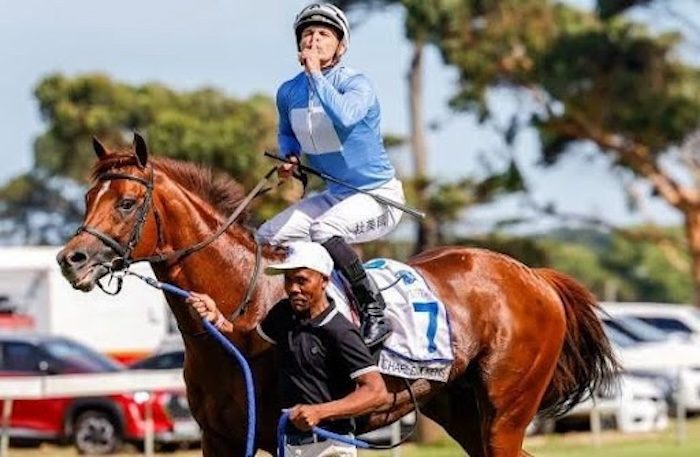On January 5, Robbie Miller turned 57 years of age.
The very next day (Saturday January 6), his farrier team at Miller Forge and Horseshoeing, provided the Cape Town, South Africa racetrack farrier with a special birthday present by shoeing all nine winners at the prestigious L’Ormarins King’s Plate (LKP) meeting held in South Africa.
Robbie himself shod the LKP winner, Charles Dickens and two other horses.
He reckons this rare feat could be a record of some kind, in modern racing history. There is nothing on file anywhere for this category, and his leading upcountry colleagues Andy Rivas and Robbie Dawson have so far missed the same achievement by one daily winner at various race meetings.
Farriery is a noble profession, and its traditions are close to Robbie’s heart. He is an Associate of London’s Worshipful Company of Farriers, a company that dates back to 1356, and can proudly write the level 5 occupational qualification “AWCF” next to his name. There are only 350 Associates in the world and just two in South Africa, the other being farrier Johnny Murdoch.
9 Shod Horses, 9 Winning Horses
South African farrier Robbie Miller and his 5-man crew shod all nine of the winning horses on the early January day of the 2024 prestigious L’Ormrins King’s Plate meeting. This shoeing experience might qualify for the Guinness Book of Records unless it has been topped by another farrier somewhere in the world.
If you’ve had an exceptional shoeing day like this one when you and your team shod all a track’s winning winners, please let know by sending a note to lessitef@lessitermedia.com.
Miller and his five qualified employees (including sons, Calven and Clinton) shoe horses for a number of trainers with multiple champion horses among his regular clients.
Some regard farriery as something of much lesser importance than, for example, veterinary services or training horses. However, Miller stresses that qualified farriers are experts on lower equine limb concerns and that their professional assistance is essential to the well-being of horses and the success of any stable.
The Farrier’s Role
The primary role of the farrier is to ensure balance, support and overall health of a horse’s soundness by trimming, shaping and shoeing its feet.
“There are racing fans who think we put the shoes on quickly and simply go on to the next horse,” he says. “But it goes way beyond that. We work alongside trainers and veterinarians to prevent injuries and hoof-related issues and to address existing hoof problems which can lead to lameness, abscesses, cracks and diseases. Hoof care schedules and treatment plans are part of the overall service.”
One of his clients, Drakenstein Stud, has a meticulous foal-care program. “The team at Drakenstein is so successful because they attend to detail,” says Miller. “Our part of their inclusive foal strategy is to look after the young horses’ feet from the moment they start walking around the paddocks. Everything we do is logged, there is a recorded history for every horse for control and reference.”
Miller’s association with the cream of breeders and a number of world-class trainers has allowed him to work with many track stars. His personal roll of honor reads like the who’s who of Thoroughbred performers in South Africa.
“All trainers will tell you that every individual horse has a different nature and temperament and that’s the way farriers also experience them,” says Miller. “They all have different habits and mannerisms in or around their stables and we have to adapt to those.
“Some Thoroughbreds are easy, some are busy and difficult, especially the colts. This year’s L’Ormarins King’s Plate winner, Charles Dickens, has been an uncomplicated customer. He has good feet and is easy to shoe. Horses get attached to their grooms and sometimes also to us. This is natural because we see them every 3-4 weeks.
“Some have peculiarities. Dancer’s Daughter, for instance, would not allow you to stand up straight next to her. When in her company, I had to remain bent over. When I stood up, she refused to cooperate.
“Clouds Unfold would not let you touch her before she was comfortable in a spot of her own choosing. When she saw me coming, she’d move, step by step, to a happy place, somewhere in her stable before she would signal that she was ready for shoeing. It had to be done on her terms.”

Robbie Miller says qualified farriers must be experts on lower equine limb concerns. Photo by: hamish NIVEN Photography
As for special attachments, Miller enjoyed a special bond with a little guy he refers to as Doug. “Doug is a very small colt that suffered hoof problems when he was in training,” he says. “He is by an unfashionable sire out of a poorly performed mare and after battling with him for a while, his owners pulled the plug.
“I’d grown very fond of this little chap, so I took Doug to our smallholding in Joostenbergvlakte and eventually his hooves healed.
“My fiancé, Trish, worked with him, as she is as passionate as I am and very good at finding homes for horses. Doug was given to one of my very good friends, is now learning polo cross and doing very well.”
Military Training Started His Farrier Career
Miller obtained most of his farrier skills in the South African Defense Force’s mounted unit to which he was assigned in 1987. He credits Sergeant Grant Store and his uncle, the late jockey-turned-trainer Arthur Miller, as being his mentors. “Sergeant Store was an old school soldier and horseman; he gave those who didn’t listen a good backhand to the ear,” he says.
In later years, following trips to the Kentucky Horseshoeing School and the World Blacksmiths’ Championships in Canada, Miller refined his skills with the help of numerous master farriers. This led to a close friendship with Chris Gregory, founder of the Heartland Horseshoeing School in Lamar, Mo., and author of the widely acknowledged Gregory’s Textbook of Farriery and a member of the International Horseshoeing Hall of Fame.
Giving Back to the Profession
Miller was inducted into the International Horseshoeing Hall Of Fame in 2023 and was the first farrier on the African continent to be bestowed with this honor.
Locally, he is the Vice President of the Southern African Association of Professional Farriers (SAAPF) and serves as a chief examiner for the Farrier International Testing System (FITS) examinations.
“In 2009 Chris Gregory wrote an exam for Brazil, and so I asked him to bring it to South Africa,” says Miller. “That’s how the (FITS) came to be, and it is now written in eight countries.”
“Every horse has a different nature and temperament…”
He has also been in discussions with the government through the Council of Equine and Equestrian Professionals of South Africa (CEEPSA), which is the professional body for the country’s equine and equestrian industry.
“We have been working to get a law passed that will make it compulsory for farriers to write the exams and register with the SAAPF as qualified workers in their trade,” adds Miller. “You won’t let an unqualified doctor examine your heart or a lay dentist examine your teeth, would you?”
Miller’s ambition and pursuit of excellent standards comes from his humble and trying beginnings. He grew up at the Mary Cook Children’s home from age 5 and then went to the Salvation Army Boys Home at 11. He is keen to pass on a message to youngsters who find themselves in similar predicaments and says, “Find something to be passionate about, focus on it and don’t ever give up.”
Passion lies at the root of Miler’s own remarkable progress to the top of his profession and he says: “My friends always laugh at me for going on shoeing holidays to the U.S. and Australia,” he says. “But I am driven by my passion for horses and my dedication to my craft and ensuring that the standards of farriery stay high. Believe me, if there were no qualified farriers, racing would suffer immensely, even come to a standstill. As custodians of our profession, we are responsible for teaching the next generation of farriers.”
What Makes a Good Farrier?
“There are obvious factors like physical strength, a calm demeanor and a degree of finesse, accuracy and good communication skills,” he adds. “But most of all horsemanship, which is something a horse can sense.

South African farrier Robbie Miller (left) and Missouri farrier Chris Gregory are advocates of the Farrier International Testing System (FITS). Miller is working with the government on a law that would make it compulsory for South African farriers to pass the FITS examination.
“As per my mentor, Grant Store, there is a single most important rule for a farrier: ‘Don’t Screw It Up.’ When a horse comes to you in good, sound condition, it must leave you in good, sound condition with no over-trimming or suffering the main effect of over-trimming — nails driven incorrectly.”
With a good, strong, back and all his faculties, Miller hopes to shoe for many more years, and has his sights on the very rare Fellowship of Worshipful Company of Farriers (FWCF). For this program, he is writing a thesis on mediolateral balance, which deals with balance in the context of trimming and shoeing and factors related to the function of the equine hoof and distal limb.
“There is a demand for skilled farriers and there always will be,” he concludes. “I want to play my part in ensuring that farriers are adequately trained, that the latest scientific information is researched and made available and that we have good farriers coming through the ranks.”
A man of good words and deeds. That’s Robbie Miller.
Related Content:








Post a comment
Report Abusive Comment